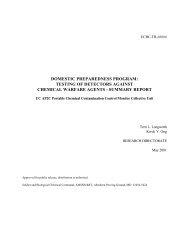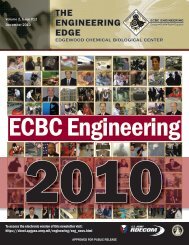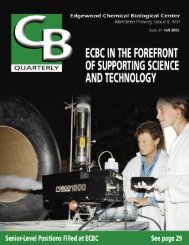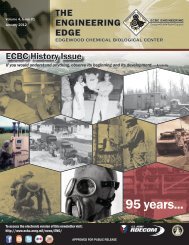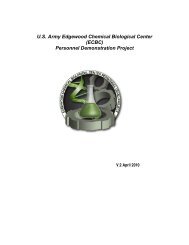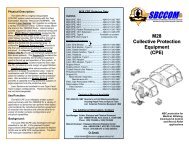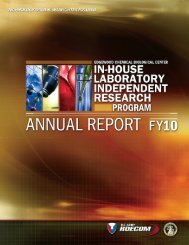(FFPE) with Self-Contained Breathing Apparatus (SCBA) for Rescue
(FFPE) with Self-Contained Breathing Apparatus (SCBA) for Rescue
(FFPE) with Self-Contained Breathing Apparatus (SCBA) for Rescue
Create successful ePaper yourself
Turn your PDF publications into a flip-book with our unique Google optimized e-Paper software.
APPENDIX D<br />
Managing the Consequences of a Chemical Attack<br />
A Systematic Approach to <strong>Rescue</strong> Operations<br />
Modified <strong>with</strong> Permission from a Document of the Same Title 5<br />
The in<strong>for</strong>mation below is intended to help first responders to a chemical agent attack develop an<br />
action plan to safely and effectively rescue live victims.<br />
Chemical protective suits compliant <strong>with</strong> NFPA 1991, Standard on Vapor-Protective Ensembles<br />
<strong>for</strong> Hazardous Materials Emergencies (<strong>with</strong> chemical-biological terrorism protection option) or<br />
the Class 1 requirements of NFPA 1994, Standard on Protective Ensembles <strong>for</strong><br />
Chemical/Biological Terrorism Incidents, (Level A suits) represent the highest level of<br />
protection to emergency responders against both respiratory and skin hazards of exposure to<br />
chemical (and biological) warfare agents. However, if the number of live victims, which are<br />
exposed to and impaired by chemical agent(s) at an emergency scene, exceeds the availability of<br />
personnel in these suits to rescue in a timely manner, the Incident Commander must consider the<br />
use of other personal protective ensembles.<br />
Turnout gear <strong>with</strong> <strong>Self</strong>-<strong>Contained</strong> <strong>Breathing</strong> <strong>Apparatus</strong> (<strong>SCBA</strong>) provides less protection than<br />
certified protective ensembles, but <strong>with</strong> operational restrictions discussed in this report, it will<br />
limit firefighter exposures to, or below, the levels that are expected to cause mild threshold<br />
chemical exposure symptoms.<br />
Saving live victims is the rescue mission, while minimizing risk of harm to the rescuers.<br />
Note: First responders must gather in<strong>for</strong>mation about the incident based on:<br />
• Signs and symptoms of casualties<br />
• Comments from casualties and onlookers<br />
• Previous responder reconnaissance or detector readings<br />
• In<strong>for</strong>mation available through intelligence provided by law en<strong>for</strong>cement officers<br />
• Site specific in<strong>for</strong>mation<br />
• Current and <strong>for</strong>ecast weather conditions<br />
Note: First responders should not assume an incident involves a highly toxic chemical agent.<br />
The released material could be a less toxic industrial chemical or a riot control agent such as<br />
pepper spray.<br />
5 Montgomery County Fire and <strong>Rescue</strong> Service (MCFRS), Montgomery County, Maryland, December 1998 ©<br />
MCFRS, Prepared by Deputy Chief Ted Jarboe, District Chief Robert Stephan, and Captain Jack Crowley <strong>with</strong><br />
technical review by Roger McIntosh, M.D.<br />
D-1



